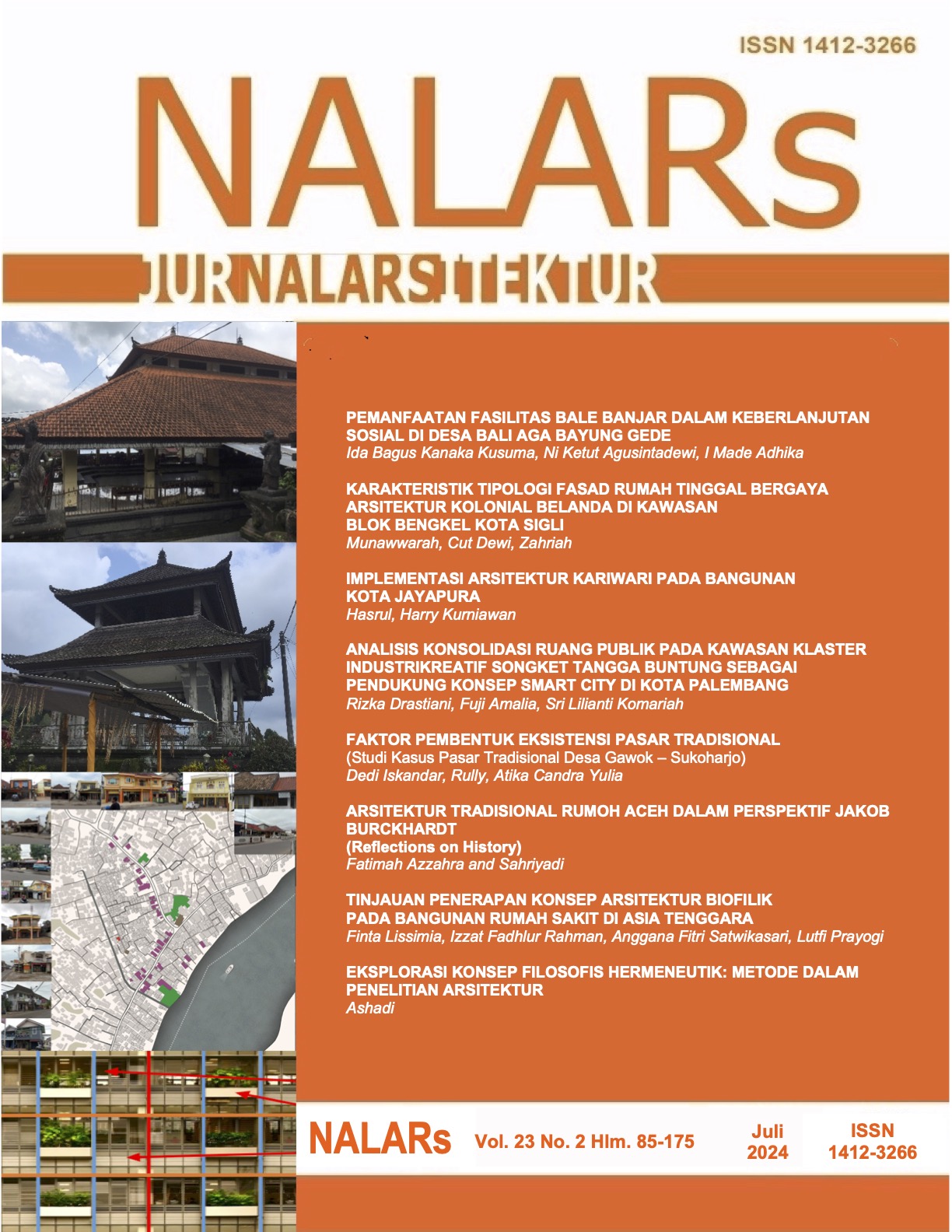FAKTOR PEMBENTUK EKSISTENSI PASAR TRADISIONAL (Studi Kasus Pasar Tradisional Desa Gawok - Sukoharjo )
DOI:
https://doi.org/10.24853/nalars.23.2.131-144Keywords:
Pasar tradisional, eksistensi, Kearifan LokalAbstract
Tujuan penelitian ini adalah mengkaji tentang faktor pembentuk eksistensi pasar tradisional pada kasus pasar desa Gawok berlokasi di Sukoharjo. Metode penelitian kualitatif dengan pendekatan deskriptif untuk mendapatkan data seperti kata-kata, gambaran secara detail tentang tentang lingkungan, aktifitas, perilaku dan tradisi pasar yang membentuk eksistensi pasar. Hasilnya didapat temuan faktor lingkungan sebagai pembentuk pasar, faktor fisik dengan pasar tradisional vernakular dan faktor non fisik yang bersifat intangible seperti pasaran Pon, tradisi dan budaya kearifan lokalnya.Hal ini menjadikan Pasar Gawok masih eksis dan bertahan di hingga sekarang. The aim of this research is to examine the factors that shape the existence of traditional markets, such as the Gawok village market located in Sukoharjo.The method of this research was qualitative with a descriptive approach to obtain the data, such as words, detailed descriptions of the environment, activities, behavior and market traditions that shapes market existence. As a result, this research found environmental factors as market shapers, physical factors with vernacular traditional markets and non-physical factors which are intangible such as the Pon market, traditions and local wisdom culture. This means that Gawok Market still exists and survives to this day.References
Aliyah, I., Setioko, B., & Pradoto, W. (n.d.). EKSISTENSI PASAR TRADISIONAL DALAM KEARIFAN BUDAYA JAWA (Obyek Studi: Pasar Gede Kota Surakarta).
Arikunto. (1998). Prosedur Penelitian Suatu Pendekatan Praktek (11th ed.). PT Rineka Cipta.
Ching, F. D. K. (2008). ARSITEKTUR : Bentuk, Ruang,dan Tatanan.
Creswell, J. W. (2009). Research design :Qualitative, quantitative, and mixed methods approaches (3rd ed.). SAGE Publications.
Habraken. (1998). The Structure of the Ordinary: Form and Control in The Built Environment. Graphic Composition Inc.
Haryadi & Setiawan, B. (2014). Arsitektur Lingkungan dan Perilaku : Pengantar ke Teori Metodologi dan Aplikasi (2nd ed.). Gadjah Mada University Press.
Junianto. (2017). Konsep Mancapat-Mancalima Dalam Struktur Kota Kerajaan Mataram Islam. SEMINAR NASIONAL SPACE #3 Membingkai Multikultur Dalam Kearifan Lokal Melalui Perencanaan Wilayah Dan Kota, 234–253.
Masner, M. (1993). Is There a Modern Vernacular ? Dalam B. Farmer dan H. Louw (Ed.), Companion to contemporary architectural thought. Routledge.
Miles, M. B., & Huberman, M. A. (2005). Qualitative Data Analysis. UI Press.
Moleong, L. J. (1994). Metode Penelitian Kualitatif. PT. Remaja Rosdakarya.
Nastiti, T. S. (2003). Pasar di JawaMasa Mataram Kuno: Abad VIII-XI Masehi. Dunia Pustaka Jaya.
Nielsen, A. (2013). Survey of Consumer Behavior and Perception toward Modern and Traditional Trade Channels (Departemen Perdagangan Republik Indonesia, Ed.).
Rahardjo, S. (2011). Peradaban Jawa : Dari Mataram Kuno Sampai Majapahit Akhir. Jakarta . Komunitas Bambu.
Rizal, J. (2013). Menguak Pasar Tradisional Indonesia. Direktorat Internaslisasi Nilai dan Diplomasi Budaya, Direktorat Jenderal Kebudayaan, Kementerian Pendidikan dan Kebudayaan.
Santoso, J. (2008). ARSITEKTUR-KOTA JAWA : KOSMOS, KULTUR & KUASA. Centropolis.
Sunoko. (2002). Perkembangan Tata Ruang Pasar Tradisional (Kasus Kajian Pasarpasar Tradisional di Bantul) [Thesis S2]. Universitas Gajah Mada.
Trancik, R. (1986). Finding Lost Space: Theories of Urban Design. Van Nostrand Reinhold.


